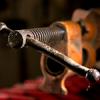I am having difficulty grinding a square edge and I am hoping to get some assistance. I have an inexpensive Porter Cable adjustable speed 6 inch grinder with a Norton white wheel. I removed the factory tool rest and installed a Veritas tool rest. I tried grinding free hand and noticed that, even on narrow chisels, the bevel was skewed significantly after grinding (I can see a lot of light when I hold a square up to the edge and I can tell just by looking at it that something is terribly wrong).
I then made a few adjustments hoping that things would improve. I crowned the Norton wheel and clamped the chisel to a straight scrap piece of wood. I also double checked the tool rest to make sure that the front and back of the rest are parallel to the cutting surface of the wheel and perpendicular to the sides of the wheel. When grinding, I made sure that the scrap of wood stayed in contact with the front edge of the tool rest as I moved the chisel back and forth. The skew of the bevel after using this method was almost identical to the skew I got when I did it freehand.
The wheel wobbles from side to side significantly. The cheap stamped washers that clamp against the wheel seem to be the culprit since they aren't machined and don't look all that flat when I lay them on top of a cast iron table. I ran then across some sandpaper to see if that would help but the shoulder on the shaft that the stamped washers press up against are tiny - not much surface to register on. I've tried different locations for the washers relative to the wheel, as many people suggest, and although the wobble is decreased, it is still pretty pronounced.
Is it the grinder or is it me?
Thanks in advance for your help.





 Reply With Quote
Reply With Quote



